Diablo 4 review - richness, luxury and compromise
Gilding the Lilith.
Try as I might, Diablo 4's endgame always remains just out of reach. My first run through the main chunk of the game, with a doomed, soon to be self-detonated Necromancer, came to an end just as Diablo 4's story did, before I hit the enforced reset before launch. My second, a wild sprint to still-not-quite-the-finish with a new Barbarian, remains ongoing. As you might've already seen, we delayed our review in part because we hadn't seen enough of Diablo 4 - but also because we hadn't seen the shop, or how its servers might fare when millions descend on it at once.
We know it's worked out surprisingly well in terms of stability - some way better than Diablo 3 infamously did, although you'd hope for that - and we know the shop has remained true to developer Blizzard's word. You can only buy cosmetics there, nothing that impacts gameplay. They are very expensive cosmetics - 10 quid horse armour feels like a twisted reference to where it all began - but they are just cosmetics. The first of Diablo's seasons, and its first battle pass, remains over a month away though, and that's a little too long for us to get to.
To talk straight down the lens for a second then, here's the plan. We're aiming to follow up on Diablo 4's endgame in proper depth further down the line. For now, I'll focus on what I've seen already. Call this a campaign review if you like - the Diablo 4 that presents itself to you after however many dozens of hours is almost a game of its own, and so best we do that game justice on its own terms later on.
But what to make of the Diablo 4 that's just Diablo 4? Play this game for dozens of hours and you'll be left with one overwhelming sensation: that soon, really soon, any minute now, it might get really good. And that what's good now comes with a lingering sense of compromise.
The compromise comes from the kind of tangle you get into with games like Diablo 4. This is a series about - among other things - the barbed hooks of grinding loot. It's a series tuned for morishness, addiction or compulsion, however you might prefer to phrase it - about playing the role of junk food and embracing that role openly. A lot of video games are junk food, ultimately, and plenty of others beyond Diablo are happy to admit it - one developer, at GDC, described these kinds of games as playing the role of "cheeseburger-makers." There's nothing wrong with that! As he put it himself: "Not everything we want to consume needs to push or provoke us, that's fine… sometimes you just want a cheeseburger."
He's not wrong - like any good yuppie I've developed strong feelings about the Maillard Reaction - but where Diablo, and games like it, get a little sticky is when you think about the details. There's little consternation about digging into the mechanics of a perfect burger, evangelising its richness and fattiness and glutinousness, because ultimately you can finish a single cheeseburger and move on, your life in balance and your overall health intact. You can't finish a Diablo. And when a Diablo gets into your system, it's much harder to get it out.
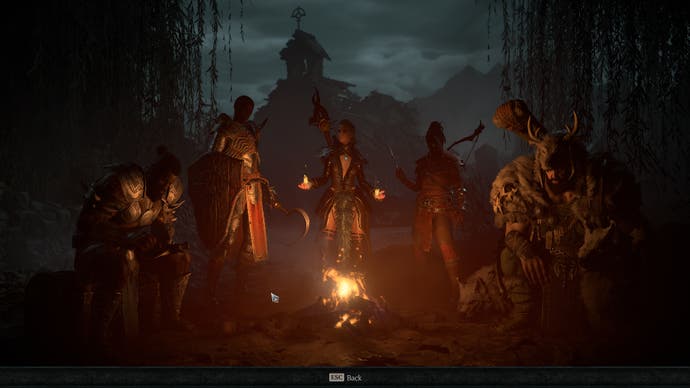

This is why the highs come with the compromise. The tension here - between all the beautiful detail that fine-tunes Diablo 4's immediate, magnetic satisfaction (what smarter writers than me have called Blizzard's clicker game), and the more objectionable side of recouping the money which makes this kind of endless mega-content possible - feels a little harder to pull apart. Abstract it from the endgame, the endless mega-content part, and the whole purpose of it all begins to crumble. Blizzard opting to wipe accounts before the game went live, ironically, almost felt like a jolt back to life because of it. A loved one bursting in and thrusting open the curtains to let in some light. Hey! The grind doesn't matter. The rewards of one battle are the rubbish of the next. The numbers will never stop going up.
Diablo 4 is more than this though. It's a game made in service to richness, to lavishness and luxuriousness. There's so much game here, and it comes from so many directions. Diablo 4 arrives with a cinematic of striking menace and obscene detail, climaxing with the demon Lilith, main antagonist and 'mother' of Diablo 4's mortal realm, Sanctuary, descending into existence from a kind of stretched-out blood cabana made from enraptured men. It gives way, admittedly, to a story that's told with a kind of out-of-place clunkiness. You spend the entire thing chasing Lillith's shadow, from one delayed third act to another (quite literally - the real third act actually comes around Act Five), and the traditional three tiers of Blizzard cutscene are present: incredibly detailed cinematics, not-so-impressive in-engine cutscenes, and comically basic conversation scenes, where your character will pivot on the spot, without animation, between two talking characters - like a child making its action figures chat. Sidequests, although there are far more still to try, have so far been unanimously one-dimensional, a range of mini-mysteries and collect-20-bone-dust-athons that give you a chance to talk to the odd, inevitably suffering side character and pick up some texture from the world, but will ultimately work their way home to the only possible answer: something's wrong; a demon did it; kill the demon.

But that hiccup aside - phwoar. Diablo 4's environments are finely drawn to the point of near-excess, each dark little cobwebbed corner that you'll likely never visit as intricate when scrolled-into at maximum closeness as the game's grand altars and vast tapestries are from the usual distant view.
And no game sounds like this. Lorath, the down-and-out Horadrim who takes the role of this game's Deckard Cain, is voiced here by Ralph Ineston, a character actor from prestige dramas Game of Thrones, Chernobyl and The Green Knight, amongst others. His noble Leeds accent is rendered in game with an almost comically luxurious, velvety fidelity, a regal voiceover delivered by a man you will at one point find passed out pissed amongst stable muck. Diablo 4's score is similarly majestic - literally full of actual majesty, enough Catholic maximalism to make Warhammer 40k's Emperor feel jealous. It's a long way from the simple, decidedly different strums of original Diablo, although they still appear from time to time.
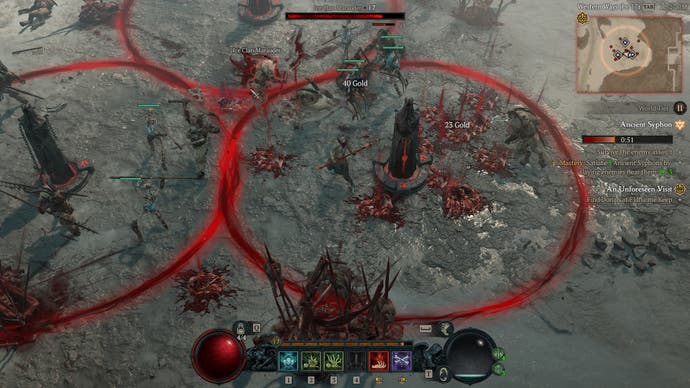

But the genius is in the way Diablo 4's sounds are designed to be zoned out - how they're tuned to the ear of someone who, before anything else, is ultimately only here to whack a skeleton. Somehow Blizzard's found a way to let epic choirs and orchestras also make for quite unobtrusive background music for religious slaughter, a kind of Space Marine chillhop. And the real magic of sound design kicks in now: in combat for one, the pings and zips of your abilities, the gloop of a blood orb - fellow Necros will know - or the thunk of a two-handed hammer. Somehow, the Platonic ideal of a thunk. This is classic Blizzard. But more than just the combat, it's in the afters - listen to the menu sounds, the unsocketing noise, the chings of scattered gold coins and clangs of new gear falling to the ground. The authentic sonic boom of levelling up. Hear those and try not to salivate.
Combat itself in Diablo 4 can be a delight, and it can also be a dirge, and the temptation is to blame this on the ugly grind. For the first 20, maybe 30 levels, you might feel a little underwhelmed, the promise of something better - loot, skills, abilities, combinations, battles, drama - always just around the corner, just out of reach. And so for much of the game, while it might look and sound sensational, it's not hugely rewarding, your abilities landing but with a little dissonance.
Your exact response, though, will vary quite significantly according to what class you opt for and the build you try out. There are five classes - Barbarian, Sorcerer, Rogue, Druid, and Necromancer - and a vast skill tree for each but also a distinction on how Diablo's core systems themselves work. Barbarians, a class of immediacy and directness, use the actual weapons you pick up from the ground across four slots, your abilities' sense of harmony or discord coming from which weapon you manually or automatically assign to what ability.
My first Necromancer, meanwhile, was entirely ability-based, focusing on, er, blood stuff. It felt well-optimised and carried me easily through most of the game - a magic projectile called blood lances do damage and cost essence, the class' main resource; blowing up corpses of stuff you kill gives you essence and heals you; other skills turn that healing into overpowering, which makes your spears stronger, and round the cycle we go - but was also taxing and at times repetitive to play.
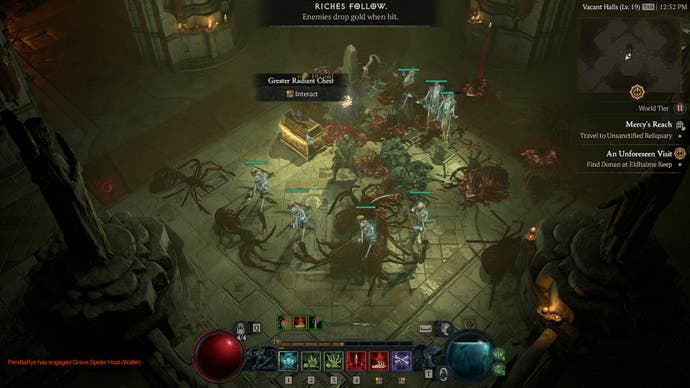
As a League of Legends player might put it (there's a traceable line here, through the unholy trinity of Blizzard, Valve and Riot Games, from Diablo through to LoL and back again), you can opt to create 'micro-intensive' builds like this, in that it requires a lot of precise inputs in a short space of time - expect to click a lot. The upside is your successes feel hard-earned and tied directly to your skill - the downside a quiet nagging that you've probably made your life unnecessarily hard. This is the difficulty with min-maxing games like Diablo. You can spoil your own fun in search of efficiency, and while efficiency can be richly satisfying - this build demanded a lot of me, and juiced my MOBA brain's urge for supreme mechanical precision in a way few other action games have - something can be both satisfying and joyless. Executing a lot of inputs efficiently for a very long time, against yet another cluster of yet another group of enemies, is a fine example.
Still, the breadth and depth of options is remarkable - a luxury like so much of Diablo 4. It's amplified by the mechanics of the mid-to-late game, as Legendary items work their way into play. These come with unique bonuses that you can extract and then add - once, as I understand it - to another item, and can create more actively noticeable differences, like a bubble-shield barrier that spawns periodically when you take damage. Really, there's little fun to be had until this stage of the game, where you'll have unlocked enough skills to start getting a little whiff of synergy here and there along with the actually interesting item buffs.
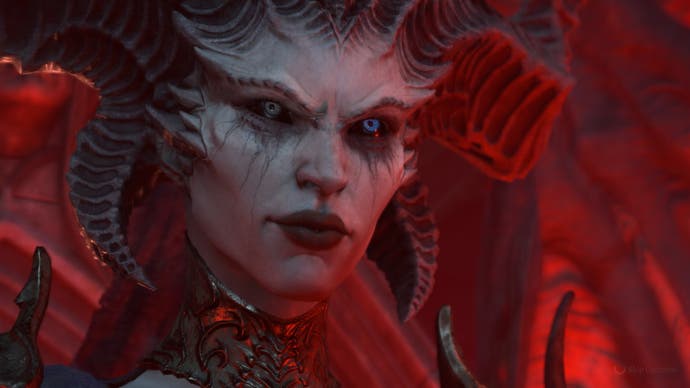
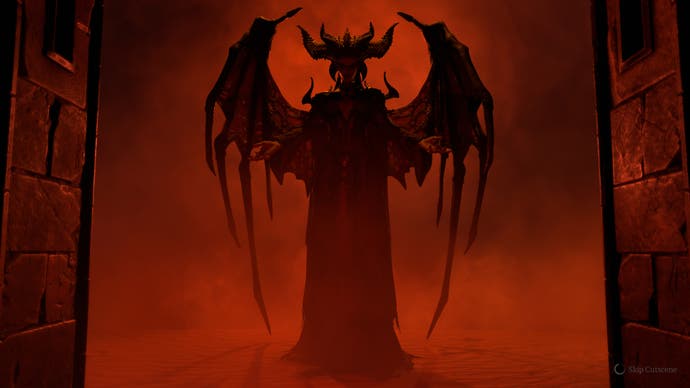
It takes a little too long to get there, but when you do, there's wonderful thoughtfulness and again, luxurious detail. Diablo 4 has what I would call a sumptuous tooltip system, which auto-expands when you hover over anything containing a keyword, but also forms part of a system where you can search for keywords - like Overpower, for instance - and see all the skill nodes of the tech tree that contain that word highlighted. It makes build-planning and discovery far easier, but arguably does less to encourage experimentation than the other kind of techniques we've seen developers take. Re-speccing your build by refunding skills is cheap and perfectly doable, but never encouraged or rewarded. The inclusion of any cost at all - in the form of gold - is if anything a slight disincentive, and it feels like the one major design misstep with Diablo 4. Where Diablo 3 made the unlocking of skills a reward itself, in Diablo 4 trying new or alternative ones out is met with minor punishment.
Still, there is at least a vast space allowed for you to try it out, and if the entirety of the story is saved for a sense of gets-good-soon, it is at least a chance to fail with less consequence. There's so much to do here, so much breadth across a big overworld and its reams of dungeons, ranging from two-room cellars with a mini boss and a chest, to vast Strongholds or sections with specific Legendary Aspects for reward.
The most fun of all, though, comes from mucking about in the little ways that feel almost antithetical to what Diablo 4 wants. Playing with character names and labels, dubbing myself Unholy Dancer or Sacred Trash - clearly that's some intentional silliness, from Blizzard, at last - or naming myself after anyone from that viral list of 18th century Quakers (Persilla Pye made it in for my Necromancer; sadly Reuben Rawbone was too many characters for my Barbarian). But any kind of silliness like this almost feels like an act of rebellion against what Diablo 4 wants to be - or more accurately, is worried about being seen as.
This is the real sticking point. Take the tone and atmosphere, the visuals that've been reduced in fan conversations to 'art style'. As much as Diablo 4 is beautiful in one sense - beauty being the word we often use when we mean to say 'high fidelity' in games - Diablo 4's world is aggressively ugly. High-fidelity ugly: exquisitely rendered headless bodies and bodiless heads, dismembered bodies, disembowelled bodies, intricately drawn bodies on crucifixes and pikes and spikes and piles of other bodies all stacked on top of one another. Fine crafted faces trying to smoosh themselves through some kind of satanic goo. Grey stone, brown fields, beige deserts, putrid swamps. Combined it all feels a bit silly, but silly by accident, its impact dulled by a bit of cumulative desensitisation. You will be in places that ought to be horrific beyond comprehension but instead feel a little bland, almost tame, but all mixing together to make a kind of pink-and-brown slurry smeared across the world. So much self-seriousness for something with the texture of a pre-formed chicken nugget.
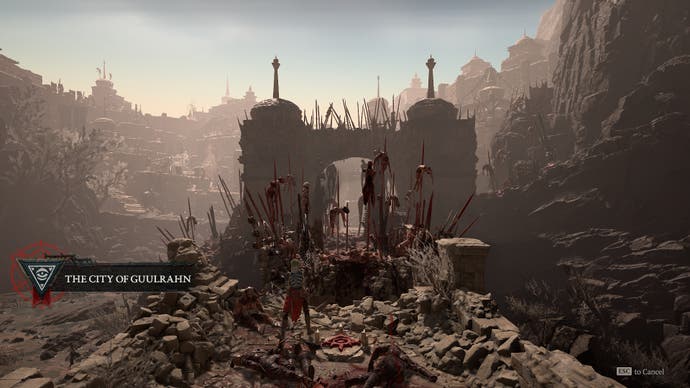
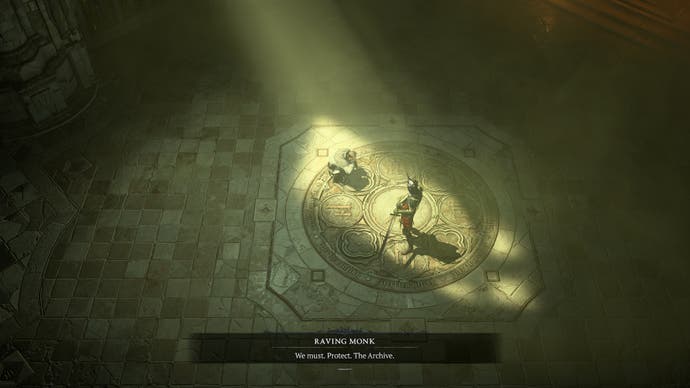
Again though, the gore really isn't the problem - it's an attitude thing. What you get from Diablo 4 is a sense of a developer that's become slightly kowtowed, slightly timid, overcompensating for perceived past transgressions and so now simply doing as it's told. The entire packaging of Diablo 4 fits that, the more you look at it. Diablo 4 obeys the sacred rules. Microtransactions may exist on the condition that they are cosmetic and/or part of a battle pass, and not pay-to-win and not loot boxes. Skills must be part of a classic skill tree. The endgame must be fully-fledged at launch and provide a platform for infinite future 'content'. Diablo must be grim and dark. You must not be able to play it without the curtains closed.
Bore off! The problem with doing as you're told as a developer is that you will always find more people to tell you what to do - we're a day after the full launch, and forums have already filled with complaints about characters being nerfed. At its high points Diablo 4 feels ridiculous, absurd, operatically over-the-top, a story of comical cosmic nonsense. At its worst it's a cage of gilded content, made bespoke to fit its loudest fans and hold them enraptured in their own complaints forever more. Starting with Season 1, available for £8.39 this July. I love a bit of grimness and gristle as much as anyone, I love poring over item spreadsheets and damage stats, and getting hooked and lost in systems. I love it in Diablo 4. And a bit of seriousness is a part of Diablo's soul - but so is a bit of nonsense, and I'd love its dark side and its boundless generosity more if I felt its makers truly believed in it, and were making it, first, for themselves.
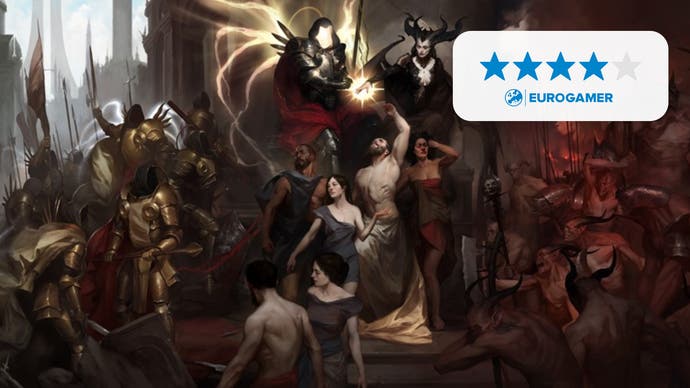








.webp?width=291&height=164&fit=crop&quality=80&format=jpg&auto=webp)
